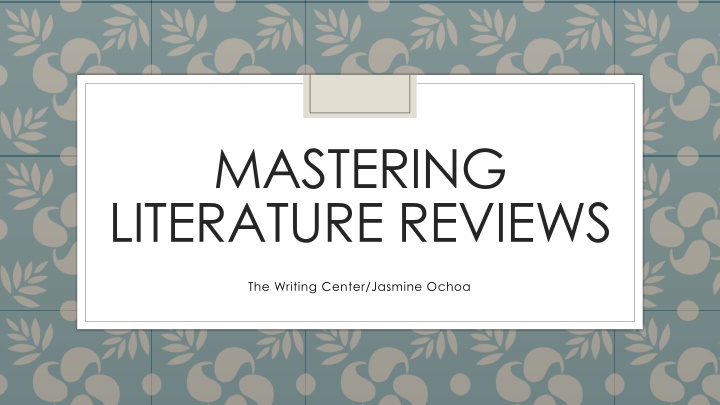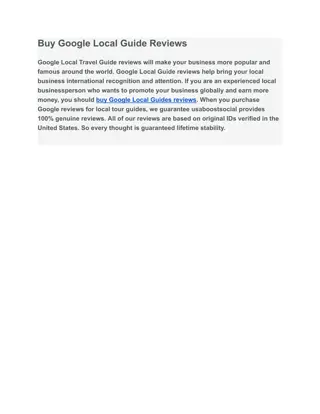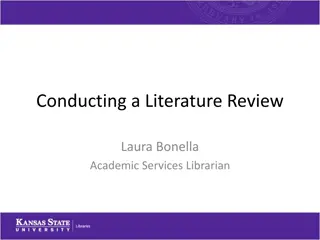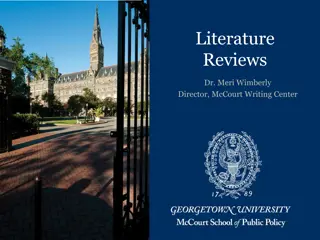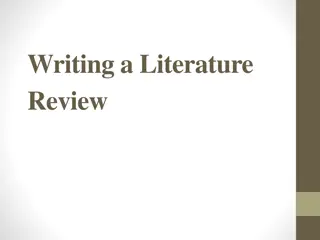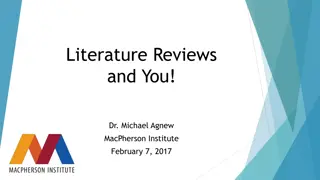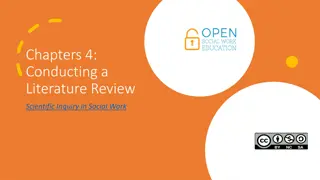Mastering Literature Reviews: A Comprehensive Guide for Writing Success
A literature review is a critical discussion of relevant information on a specific topic, involving problem definition, interpretation, and identification of research gaps. It is not a mere collection of sources but a synthesis that guides further investigation. Incorporating APA style tips, this guide emphasizes proper citation and the structure of a literature review within an academic assignment.
Download Presentation

Please find below an Image/Link to download the presentation.
The content on the website is provided AS IS for your information and personal use only. It may not be sold, licensed, or shared on other websites without obtaining consent from the author.If you encounter any issues during the download, it is possible that the publisher has removed the file from their server.
You are allowed to download the files provided on this website for personal or commercial use, subject to the condition that they are used lawfully. All files are the property of their respective owners.
The content on the website is provided AS IS for your information and personal use only. It may not be sold, licensed, or shared on other websites without obtaining consent from the author.
E N D
Presentation Transcript
MASTERING LITERATURE REVIEWS The Writing Center/Jasmine Ochoa
Literature Review A discussion of relevant information on a given topic that defines and clarifies the problem; shows a progression; interprets material; highlights contradictions, gaps, or inconsistencies in current research; suggests further research and investigation.
A Literature Review Is . . . Is Not . . . A synthesis of multiple sources Organized around specified topics and themes A text that provides current scholarship on a given topic A demonstration of your knowledge of the topic Properly cited A general summary of each source An annotated bibliography Driven by your personal opinion A collection of direct quotes from various texts
STAND ALONE WITHIN ANOTHER ASSIGNMENT Some summarizing Analysis Connecting the literature to your research topic How does the literature fit into your research topic? How is the literature assisting your topic? Be sure to include a transition leading into the next section of your writing assignment Some summarizing Analysis Connecting it to a main focus/subject How does the literature (typically more than one piece of literature) connect to your focus? How is it or is it not relevant to your focus?
APA Style Layout 1. Title Page 2. Abstract- may or may not be required depending on professor s request (Minimum 150 words) 3. Introduction 4. Specific headings (i.e. findings, methods, specific topics within your subject area) 5. Conclusion 6. References (Always place on a separate page)
Other APA Tips Time New Roman, 12-point, double spaced. Do not change the margins in Word. The running head must match the title exactly, up to 50 characters. The words Running head should appear only on the cover page. CITE ALL INFORMATION YOUR DERIVE FROM ANOTHER SOURCE! Only material cited within the paper can appear on the Reference page. Alphabetize the Reference page. Format all references in a hanging indent. Stop relying on the internet; utilize journal articles and books.
Organization Purpose Helps familiarize with field/topic Exposes you to multiple studies in your field Dissertations, textbooks, scholarly journal articles, conferences, data Can be useful for later assignments Compare and contrast multiple texts in the field Problem formulation Literature search Data evaluation Analysis and interpretation
Ways to Organize a Literature Review Chronological (by decade, era, etc.) Trend Theme Advancement Geography Methodological
Process Collect articles from databases. (Don t neglect books!) Analyze each source. Skim their abstracts and other major sections. Take notes. Locate the author s/authors main idea. Arrange the sources into their proper order based on your outline. Provide transitions between each section.
A literature review should Define and clarify a problem Summarize previous investigations to inform the reader of the state of research Identify relations, contradictions, gaps, and inconsistencies in the literature Suggest the next step or steps in solving the problem (Publication Manual of the American Psychological Association, 2010, p. 10)
Inform readers of the key concepts and ideas. Bring readers up to date about the history of this topic. Narrow your focus as much as you can.
Video https://www.youtube.com/watch?v=-ny_EUJXHHs
*Reminders Stay focused on your chosen topic- connect each text to that topic If you are using the review within a larger assignment be sure to have it lead into your own research It will be helpful to first choose your topic and then search for related literature After finding related literature it may be helpful to create an outline or a list of bullet points within that specific piece of literature to stay organized
More Reminders Group articles by category. Find the methodological strengths and weakness of your research material. Report on evidence, not the author s/authors assertions. (Key words: may, is thought to, could, possible, these assertions). Always strive to utilize primary sources. Adhere to proper style and mechanics (no slang, colloquialisms, contractions, or sexist language). Include topic sentences and concluding sentences. Don t completely lose your voice. Make judgments about the work. Use direct quotes sparingly.
References Galvan, J. L. (2014). Writing literature reviews: A guide for students of the social and behavioral sciences (6thed.). Glendale, California: Pyrczak Publishing. Write a literature review. (n.d.). Retrieved from http://guides.library.ucsc.edu/write-a-literature-review Publication Manual of the American Psychological Association. (2010). Washington, DC: American Psychological Association.
